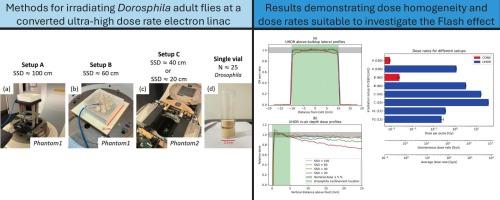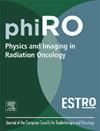研究超高剂量率直线放射治疗下黑腹果蝇的闪效应
IF 3.3
Q2 ONCOLOGY
引用次数: 0
摘要
背景与目的超高剂量率放射治疗因其闪光效应而拓宽了治疗窗口。实验性线性加速器已转换为超高dr,以收集临床前证据。增加可及性、吞吐量和研究额外的生物端点是破解Flash效应机制的关键。本研究的目的是开发和表征一个用果蝇(即果蝇)进行UHDR实验的实验平台。材料和方法对一种临床直线加速器进行了改进,使其能够在UHDR和常规(CONV)模式下输出16 MeV的电子束。两个幻影被开发用来照射黑腹果蝇。表征是基于主动(超薄离子室原型,闪烁体)和被动探测器(放射性变色薄膜,OSLD)。此外,利用额外的专用模体研究了超高压光子的超高dr能力。结果电子UHDR辐照的平均剂量率为200 ~ 7500 Gy/s。单瓶内光束空间均匀性优于±5%。以不同形态和光束方式给黑腹果蝇的剂量确认为±5%水平。光子特高压辐射的平均剂量率达到40 Gy/s以上。结论:该高通量实验平台在经过改装的临床线性加速器上,可用于比较CONV和UHDR,每周最多500只动物,生物终点高达1000 Gy。在一个改装的临床直线加速器上,也首次证明了光子巨压UHDR辐射的产生。本文章由计算机程序翻译,如有差异,请以英文原文为准。

Development and characterization of phantoms to investigate the Flash effect with Drosophila melanogaster at an ultra-high dose rate radiotherapy linac
Background and purpose
Ultra-high dose rate (UHDR) radiotherapy may widen the therapeutic window thanks to the Flash effect. Experimental linear accelerators have been converted to UHDR to collect pre-clinical evidence. Increasing the accessibility, throughput and investigating additional biological endpoints is key for deciphering the mechanism of the Flash effect. The aim of this study was to develop and characterise an experimental platform for UHDR experiments with Drosophila melanogaster, i.e. the fruit fly.
Materials and methods
A clinical linear accelerator was modified to deliver 16 MeV electron beams in UHDR and conventional (CONV) mode. Two phantoms were developed to irradiate Drosophila melanogaster. The characterization was based both on active (ultra-thin ion chamber prototype, scintillator) and passive detectors (radiochromic films, OSLD). Moreover, the UHDR capabilities for megavoltage photon were investigated with an additional dedicated phantom.
Results
The electron UHDR irradiations provided average dose rates in the range of 200–––7500 Gy/s. The beam spatial uniformity within a single vial was better than ± 5 %. The dose delivered to Drosophila melanogaster in different configurations and beam modalities was confirmed to the ± 5 % level. The average dose rate achieved with photon megavoltage UHDR radiation reached beyond 40 Gy/s.
Conclusions
This high-throughput experimental platform on a converted clinical linear accelerator could be used to compare CONV to UHDR for up to 500 animals per week for biological endpoints at up to 1000 Gy. The production of photon megavoltage UHDR radiation was also demonstrated for the first time at a converted clinical linac.
求助全文
通过发布文献求助,成功后即可免费获取论文全文。
去求助
来源期刊

Physics and Imaging in Radiation Oncology
Physics and Astronomy-Radiation
CiteScore
5.30
自引率
18.90%
发文量
93
审稿时长
6 weeks
 求助内容:
求助内容: 应助结果提醒方式:
应助结果提醒方式:


